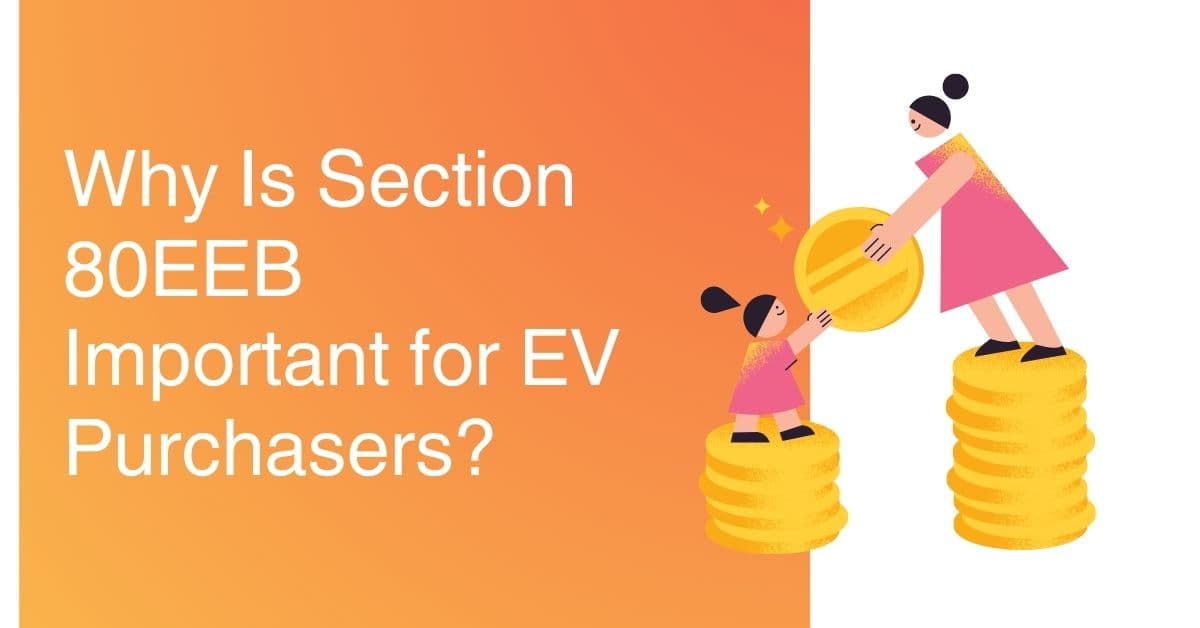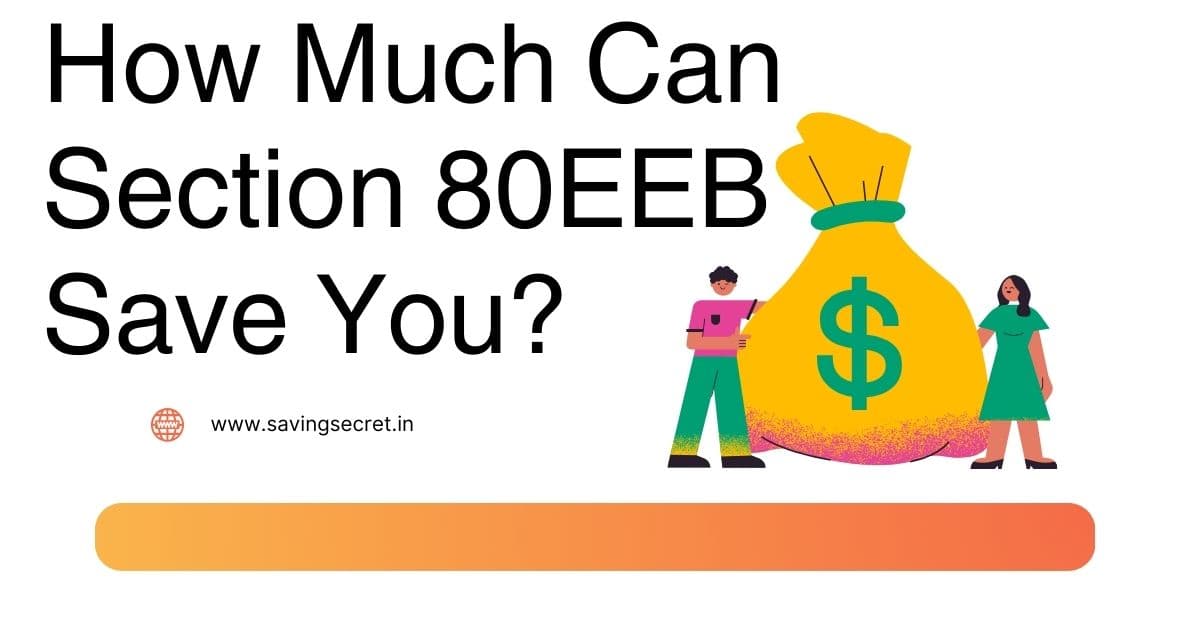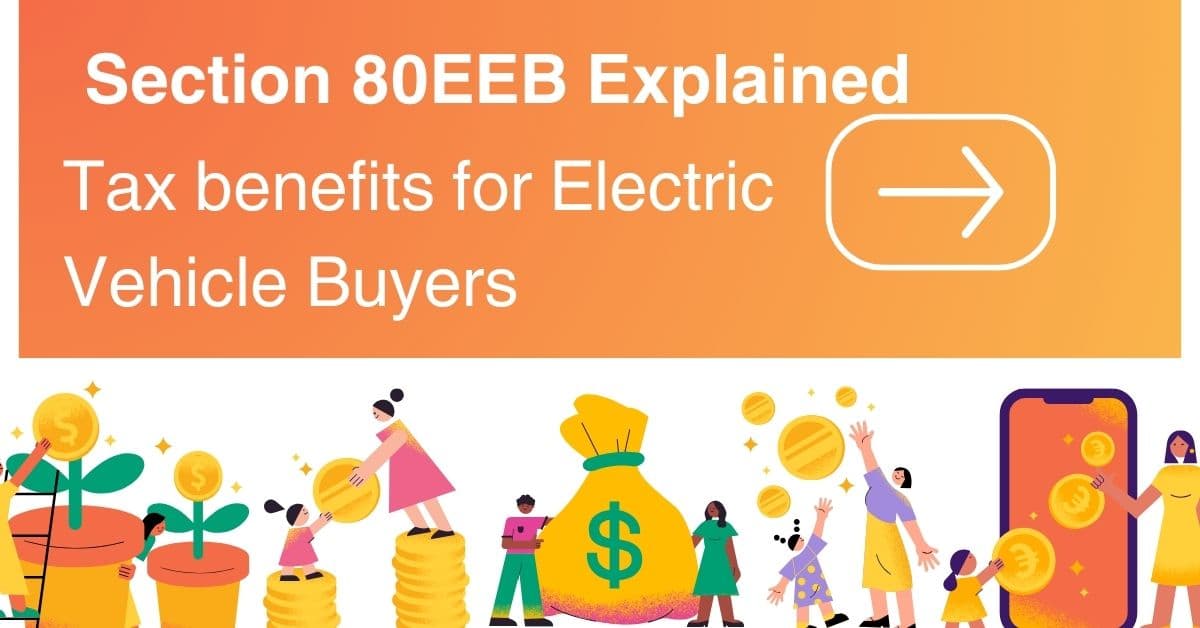Section 80EEB Explained: Electric cars (EVs) are becoming more and more popular in places like Delhi, Bangalore, and Mumbai as India speeds towards a greener future. Purchasing an electric vehicle or two-wheeler, such as a Tata Nexon EV or Ather 450X, is more alluring than ever because of government incentives encouraging adoption and the fact that over 1.5 million EVs would be sold by 2025 (per SIAM forecasts). Here’s the icing on the cake, though: The Income Tax Act of 1961’s Section 80EEB provides tax deductions for EV loan interest, further lowering the cost of your eco-friendly vehicle.
This tax credit may save you thousands of rupees, whether you’re a company owner in Kolkata considering a fleet, a freelancer in Chennai purchasing a ₹3 lakh electric scooter, or a salaried professional in Pune financing a ₹15 lakh EV. The time to take advantage of these advantages is now, as the tax season (July 31, 2026, for FY 2025-26) approaches and India’s digital economy is expanding—UPI transactions reached 14.4 billion in February 2025. Now let’s explore how Section 80EEB operates and how you may begin to claim tax savings for your electric car!
Why Is Section 80EEB Important for EV Purchasers?
A tax law known as Section 80EEB was implemented in 2019 to encourage environmentally friendly transportation in India. It enables people to claim a deduction from their taxable income for interest paid on loans carried out to purchase electric vehicles, such as automobiles, motorcycles, or commercial EVs. For EV purchasers facing loans with interest rates between 8 and 12%, it’s a strong inducement because there is no limitation on the interest amount, unlike Section 80C’s ₹1.5 lakh maximum.
Why it’s important:

- Tax Savings: With a 4% cess, a ₹50,000 interest claim in the 30% slab saves ₹15,600.
- Reasonably priced EVs: reduces loan costs: a 9% loan of ₹10 lakh feels like 6% after taxes.
- Eco Impact: Helps India reach its 2030 EV adoption target of 30% (NITI Aayog).
- Financial Relief: Provides funds for EV charging, SIPs, or savings.
- No upper limit: Take advantage of ₹31,200 (30% slab) and claim ₹1 lakh in interest.
Given that industry projections indicate that EV loans would total ₹50,000 crore by 2025, Section 80EEB is essential information for Indian taxpayers. Let’s dissect it.
Key Information for Understanding Section 80EEB
What You Are Only Entitled to:
- Interest Only: On an EV loan, deduct interest rather than principle.
- For instance, a ₹5 lakh loan with 9% interest spread over five years and ₹10,000 in EMIs consists of ₹6,250 in principal (not claimable) and ₹3,750 in claimable interest.
Who Qualifies
- Borrower: Borrowers must be individuals (self-employed or salaried), not HUFs, businesses, or enterprises.
- Purpose: The loan is intended for use with electric vehicles, including automobiles (like the MG ZS EV), two-wheelers (like the Ola S1), and commercial EVs (like e-rickshaws).
- Eligible Loans: Loans from NBFCs (Bajaj Finance), banks (SBI, HDFC), or other authorised financial institutions—not friends or family—are eligible.
- Timeline: The loan was approved from April 1, 2019, to March 31, 2023 (for extensions in 2025, check).
Deduction Limit
- Max: The annual maximum deduction for interest (when coupled with additional deductions, such as Section 24 for house loans) is ₹1.5 lakh.
- Duration: For a maximum of eight years after the year you begin making interest payments or until the loan is paid back, whichever comes first.
- For instance, claims are due in March 2033 (FY 2032–2033), and repayment begins in April 2025.
Old Regime Tax Slabs, 2025
- 5% : ₹2,50,000 to ₹5,00,000 (₹2,600 on ₹50,000 interest).
- 20% : ₹5,00,001–₹10,000,000 (₹10,400 on ₹50,000).
- 30%: At least ₹10,000,000 (₹15,600 on ₹50,000) is 30%.
How to Optimise the Tax Benefits of Section 80EEB
This is a comprehensive tutorial for Indian EV purchasers that includes methods, examples, and advice on how to claim Section 80EEB deductions.

Step 1: Verify Your Loan Eligibility
- How to Proceed: Confirm that the loan is for an EV (such as the Hero Electric scooter or the Tata Tigor EV) approved by a bank or NBFC between 2019 and 2023.
- Why It Is Important: Personal loans or non-EV loans (petrol automobiles) are not eligible; ₹2 lakh from family members is not.
- For instance, Priya’s ₹1 lakh friend loan is not eligible, while Anil’s ₹5 lakh SBI EV loan is.
- Take action: by April 20, 2025, to review the loan arrangement.
Step 2: Compile the necessary paperwork
What You Require:
- Loan agreement (verifies lender and EV purpose).
- Interest certificates, which divide EMI into principle and interest, are issued by banks and NBFCs.
- Form 16 (taxable income, salary).
- Acknowledgement of ITR (if lodged in the preceding year).
- EV invoice (which certifies the purchase of an electric car).
Why It Is Important: Proof guarantees seamless claims—a certificate is required for ₹40,000 in interest.
For instance, Sunita’s claim was supported by her ₹30,000 HDFC interest certificate.
Take action: by April 25, 2025, to request a certificate.
Step 3: Calculate the Interest Amount Due
- How to Proceed: Examine the EMI statement: 9% on a 10 lakh loan equals 75,000 in interest for the first year.
- The Reason It Works: Only interest is deductible; ₹75,000, not ₹1.2 lakh in EMIs, reduces taxable income.
- Deep Dive: Early interest rates are higher—₹75,000 in Year 1 compared to ₹20,000 in Year 5 (amortisation).
- For instance, Ravi completely claimed the ₹60,000 interest he paid in 2025.
- Take action: by April 30, 2025, to calculate 2025 interest.
Step 4: Select the Previous Tax System
- How to Proceed: Choose the previous regime because the new one (2020) does not take 80EEB deductions.
- Why It Is Important: The former regime’s ₹50,000 interest saves ₹10,400 (20% slab); the new regime saves ₹0.
- Hacks: If deductions (80C, 80EEB) are greater than exemptions, the previous regime prevails.
- For instance, Priya saved ₹15,600 from her ₹8 lakh salary plus ₹50,000 in interest.
- Action: By May 05, 2025, choose the previous administration.
Step 5: Use 80EEB to file your ITR Make a claim
- How to Proceed: In “Deductions,” input interest under “80EEB” using ITR-1 (salaried) or ITR-2 (others).
- The Reason It Works: reduces taxable income from ₹6 lakh to ₹5.5 lakh, with interest of ₹50,000.
- Take a closer look: the ₹1.5 lakh restriction includes interest on house loans—₹50,000 EV + ₹1 lakh home = ₹1.5 lakh maximum.
- Example: Anil’s ₹60,000 interest, for instance, reduced the tax from ₹62,500 to ₹46,900 (20% slab).
- Take action: by May 10, 2025, by practicing ITR on ClearTax.
Step 6: Monitor Your Eight-Year Timeframe
- How to Proceed: Repayment of the note begins in April 2025 (FY 2025–26) and is claimed through FY 2032–2033.
- Why It Matters: There is a tight eight-year restriction; if you miss a year, you lose it.
- Hacks: Set calendar notifications and claim large early interest (₹75,000 vs. ₹10,000 later).
- For instance, Sunita began in 2024 and saved ₹1 lakh by claiming till 2032.
- Action: By May 15, 2025, set a reminder for FY 2025–2026.
Step 7: Add to Other Subtractions
- How to Proceed: The 80EEB should be paired with 80C (₹1.5 lakh—ELSS, PPF), and 80D (₹25,000—health insurance).
- Why It Works: ₹62,400 saved (30% slab) = ₹2 lakh deduction (₹50,000 (80EEB) + ₹1.5 lakh (80C).
For instance, Ravi’s ₹1.6 lakh off income is equal to his ₹60,000 interest plus ₹1 lakh PPF. - Take action: By May 20, 2025, budget ₹50,000 80C.
Step 8: Increase Savings by Prepaying
- How to Proceed: Reduce principal by using incentives (₹50,000), which also prolong 80EEB claims and lower interest.
- Why It Is Important: Prepaying ₹1 lakh on ₹5 lakh (9%, 5 years) saves ₹45,000 in claimable interest.
- Tips: EV loans have no prepayment penalties, so take advantage of the first few years.
- For instance, Anil paid ₹50,000 in advance, saving ₹4,680 in taxes and ₹15,000 in interest.
- Take action: By December 2025, schedule a ₹20,000 down payment.
Step 9: Make Use of Additional EV Incentives
- How to Proceed: Combine the 80EEB with state exemptions (Delhi’s ₹1.5 lakh) and FAME-II subsidies (₹15,000 for scooters and ₹1.5 lakh for vehicles).
- The Reason It Works: After the subsidies, the EV reduces from ₹10 lakh to ₹8 lakh—lower loan, lower interest.
- For instance, Priya claimed interest on her ₹12 lakh Nexon EV, which cost ₹10 lakh to ₹20,000.
- Take action: Verify your eligibility for FAME-II before May 25, 2025.
Step 10: Steer clear of typical blunders
- What to Do: Avoid omitting interest documentation, filing late, or claiming principal.
- Why It Is Important: Errors result in notices—not the EMI total, but the certificate for the ₹50,000 claim is required.
- Hacks: File by July 31, 2026 (FY 2025–2026); reimbursements are forfeited for late filing.
- For instance, Sunita’s missing certificate caused a ₹10,000 reimbursement delay.
- Take Action: Verify documents by May 30, 2025.
Step 11: Make Use of Electronic Resources
- How to Proceed: File using Quicko—auto-calculate 80EEB—and ClearTax.
- The Reason It Works: saves time and mistakes—in just five minutes, ₹60,000 in interest was input.
- Hacks: AI detects interest paid when bank statements are linked.
- For instance, after 20 days, Anil received a return of ₹15,600 for filing on Quicko.
- Take action: by June 05, 2025, to test ClearTax.
Step 12: Make a post-loan financial plan
- How to Proceed: After repayment, transfer ₹10,000 in EMI savings to SIPs.
- Why It Is Important: Wealth is created with ₹5,000 per month at 12%, or ₹10 lakh in ten years.
- For instance, Priya’s ₹8,000 EMI to SIPs will total ₹5 lakh over five years.
- Take action: by June 10, 2025, by initiating a ₹500 SIP.
How Much Can Section 80EEB Save You?

Section 80E of the Income Tax Act allows you to claim substantial tax deductions if you are repaying an education loan. For example, under the 5% tax slab, you may save around ₹2,600 year, or ₹20,800 over eight years, assuming you pay ₹50,000 in interest each year. The savings rise to ₹10,400 annually, or ₹83,200 after eight years, in the 20% tax bracket. The biggest beneficiaries are those in the 30% slab, who save ₹15,600 year, or ₹1,24,800 in total tax relief. You may save up to ₹31,200 year, or a whopping ₹2,49,600 over eight years, if your annual interest payment is ₹1,00,000 and you are in the 30% slab. These deductions serve to ease your financial load and make college loans more reasonable in the long term.
Section 80EEB Benefits for Indian EV Purchasers
- Savings over eight years: ₹20,000 to ₹2.5 lakh.
- Affordability: after taxes, a ₹15 lakh EV is equivalent to ₹12 lakh.
- Eco Win: Reduced emissions—support for India’s 2030 target.
- Credit Boost: 750+ CIBIL = On-Time EMIs.
- Future-ready: charge stations and savings fund SIPs.
Examples from Real Life
The electric scooter owned by Anil, a 28-year-old Hyderabadi man earning ₹6 lakh:
- Ather 450X loan: ₹2 lakh, 9% interest of ₹18,000.
- ₹3,744 (20% slab)—₹20,000 over five years was saved.
- “Cheaper and green,” he claims.
Priya’s electric vehicle
Priya, a Mumbai native who is 35 years old and makes ₹12 lakh:
- Nexon EV loan: ₹10 lakh, 8% interest of ₹80,000.
- ₹24,960 (30% slab)—₹1.5 lakh over seven years was saved.
- “The deal was sealed by tax breaks,” she says.
The Commercial EV of Sunita
Sunita, a 40-year-old Kolkata resident earning ₹8 lakh:
- E-rickshaw loan: ₹5 lakh, 10% interest of ₹50,000.
- ₹15,600 (30% slab)—₹1 lakh over six years was saved.
- “Savings + business,” she says.
Additional Advice for Indian EV Purchasers
- Early Filing: 15 days for reimbursements if you file by April 2026 (FY 2025-26).
- Assistance: Get ₹15,000 off a bike and ₹1.5 lakh off a vehicle when you claim FAME-II.
- Digital Ease: 5-minute ITR using Quicko and TaxSpanner.
- Loan Shopping: When shopping for a loan, compare SBI (8%) and Bajaj (10%) to save ₹10,000 annually.
- CIBIL check: Wishfin offers a free CIBIL check; 750+ receive 8% loans.
- Savings on charging: ₹500/month for home solar against ₹1,500 for grid.
- Learn: 80EEB tips on YouTube (e.g., CAclubindia).
Typical Problems and Their Solutions
- Problem: No certificate of interest.
Solution: Ask the bank for a ₹50 charge instead of a ₹10,000 loss. - Problem: A new regime was chosen.
Solution: Revert to the previous one—₹50,000 equals ₹15,600 saved as opposed to ₹0. - Problem: Doubts about loans beyond 2023.
Solution: Look for extensions in Budget 2025 and use forums to advocate. - Problem: Confusion among the principal is the challenge.
Solution: Verify the EMI split—interest solely for 80EEB—as the solution. - Problem: No taxes and low income.
Solution: Save ₹15,600 by giving the parent a 30% slab EV loan.
Why India’s Section 80EEB Is Effective
The EV market in India is expanding, with 1.5 million units expected by 2025:
- Policy Push: ₹5,000 crore in subsidies from FAME-II and 80EEB.
- Digital Shift: 70 million taxpayers using UPI and e-filing.
- Green Need: 30% EV target; uptake is fuelled by tax benefits.
Resources and Tools
- Apps: Quicko (tax), ClearTax (ITR), and TaxSpanner (regime).
- Websites: SIAM (EV data), Income Tax India (rules).
- Freebies: include YouTube instructional and EMI calculators from BankBazaar.
- Communities: For tax advice, see r/IndiaInvestments.
Get Your Benefits from 80EEB Today
Use Section 80EEB to begin saving right now:
- Collect documentation by April 20, 2025.
- Interest must be calculated before April 30, 2025.
- By July 31, 2026 (FY 2025–26), file your ITR.
Both the environment and your taxes are saved by your EV. To spread the green fortune, provide this guide to friends or EV customers. Every Indian electric vehicle owner benefits from Section 80EEB!
Tax Deduction for Education Loans Section 80E
Let AI Boost Your Tax Refund – Here’s How!
How to Use Section 80C for Tax Planning: A Beginner’s Guide!

